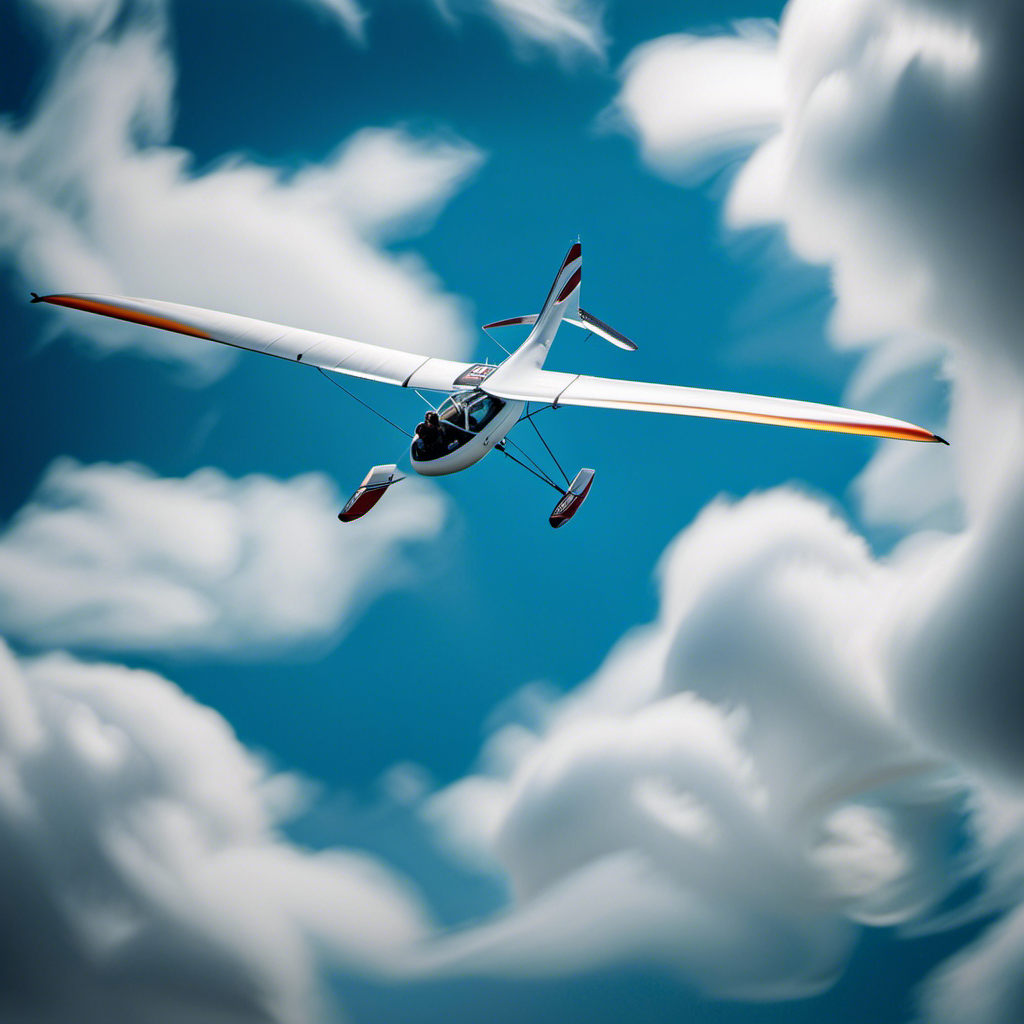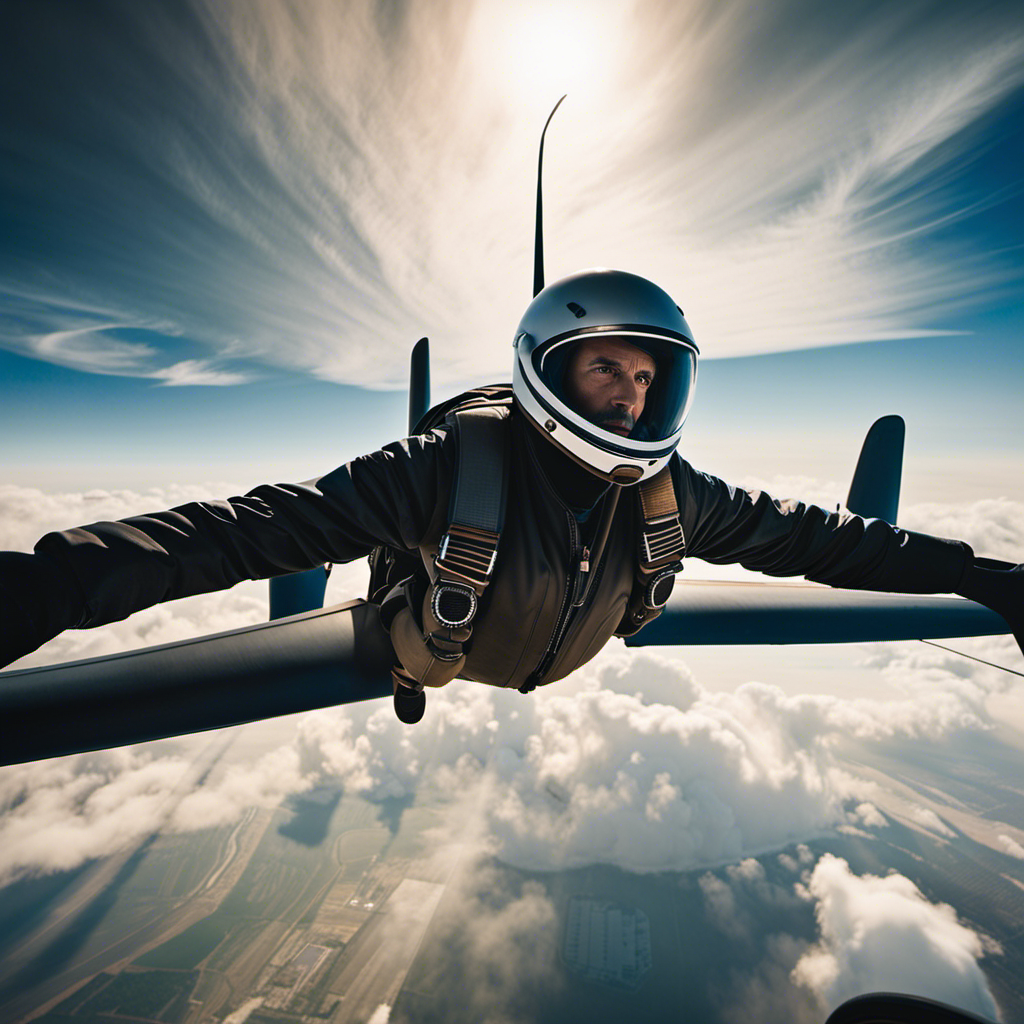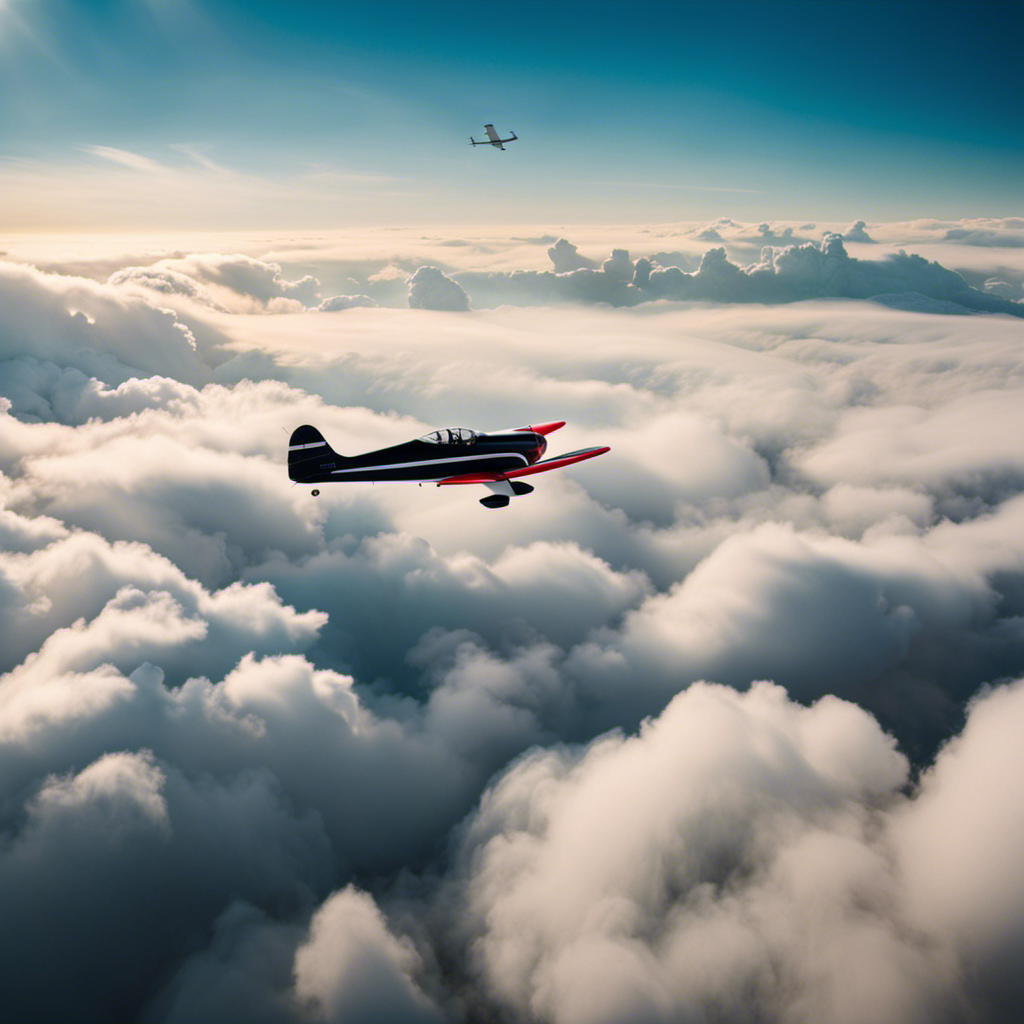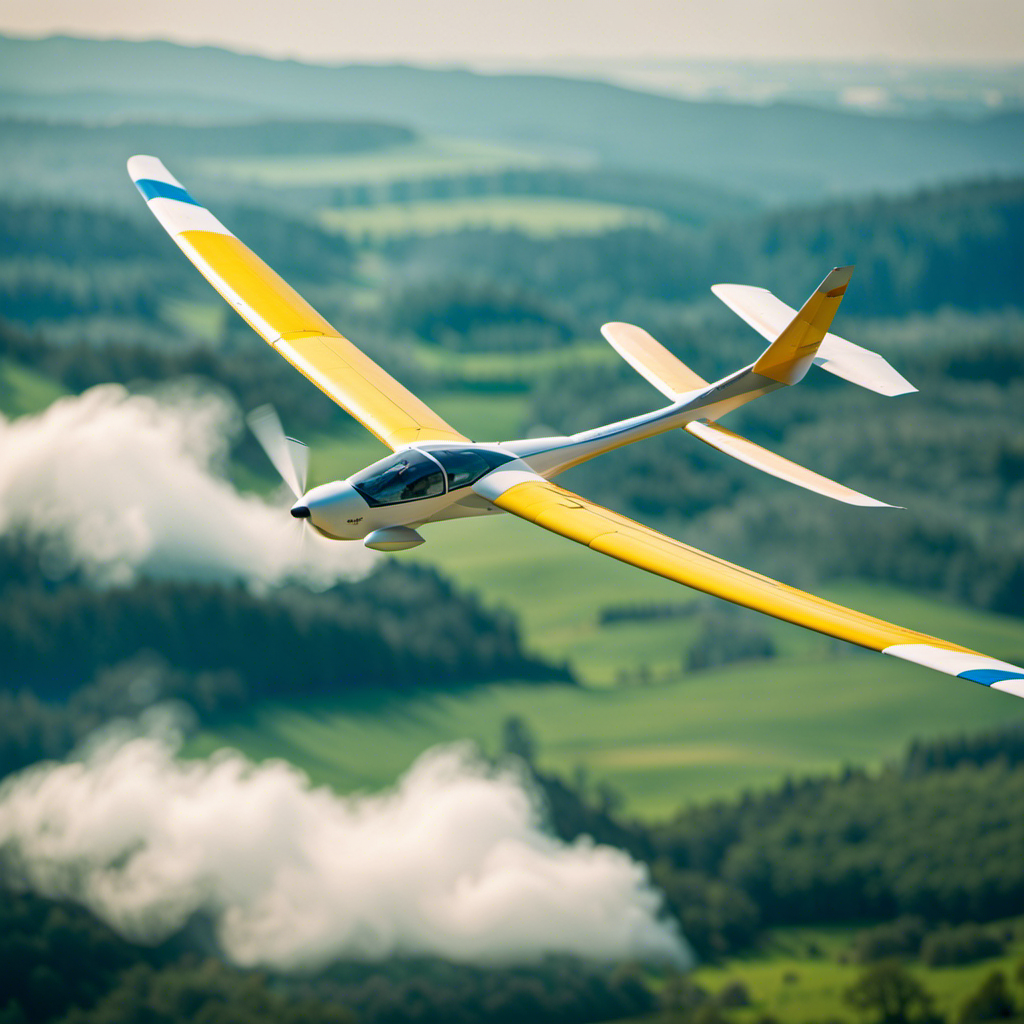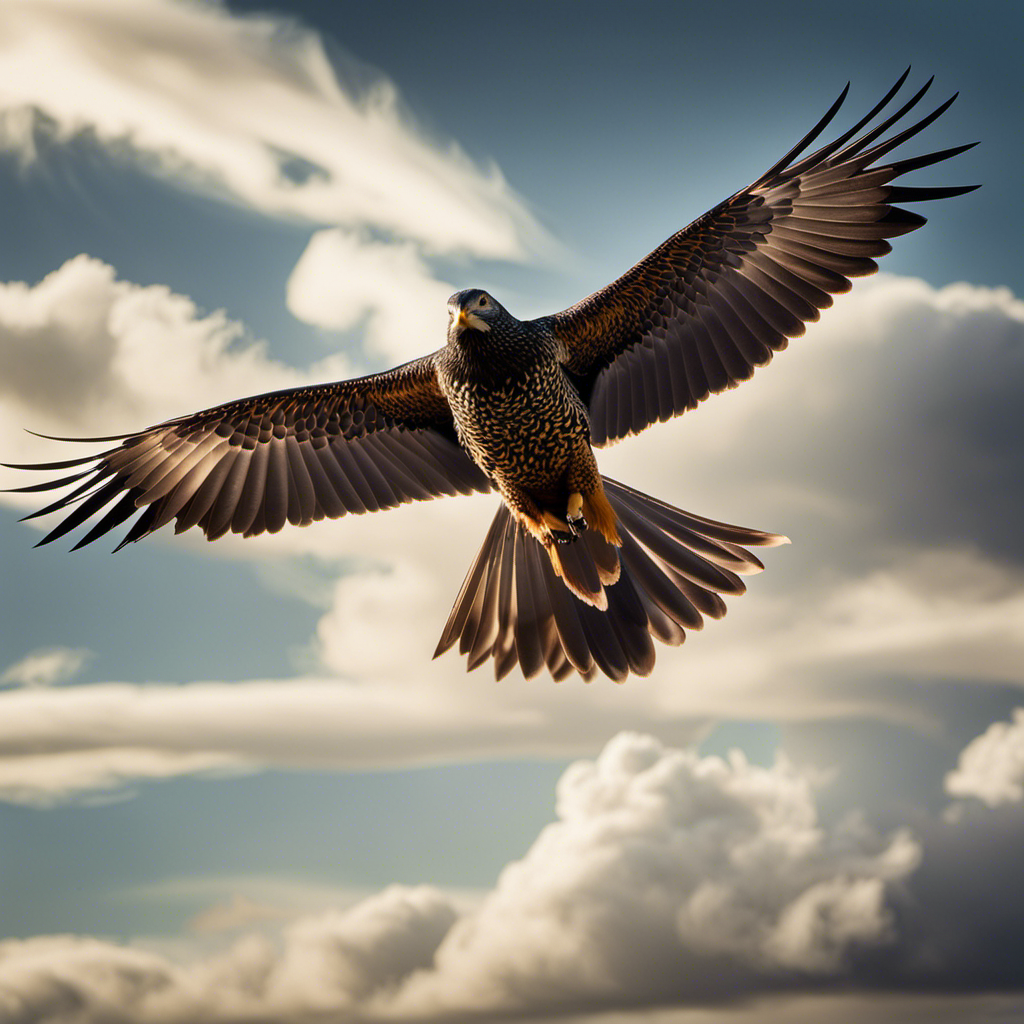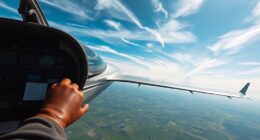As the saying goes, ‘there are no limits!’ If soaring gracefully through the sky like a bird has always been your dream, then learning to pilot a glider could be your pathway to experiencing true liberation.
In this article, I’ll guide you through the essentials of glider flight, from obtaining a pilot license to mastering navigation and weather conditions.
So fasten your seatbelt (or should I say, harness) and get ready for an exhilarating journey into the world of glider flying.
Key Takeaways
- Online forums and communities provide a wealth of information, tips, and safety guidelines for aspiring glider pilots.
- Participating in glider events allows pilots to meet experienced pilots, learn from them, and fully immerse themselves in the glider community.
- There are different types of gliders available, such as standard, high-performance, motorized, vintage, and aerobatic, each with its own characteristics and suitability for different flying conditions.
- Glider flying offers advantages like the adrenaline rush of engineless flight, discovering serene landscapes, connecting with nature, and experiencing the thrill and joy of flight.
Understanding the Basics of Glider Flight
To understand the basics of glider flight, it’s important to know what you need to pilot a glider.
As a glider pilot, I have learned that understanding aerodynamics is crucial. It involves studying the forces that act on the glider during flight, such as lift and drag. By grasping these principles, I am able to make informed decisions while flying.
Additionally, practicing proper weight and balance is essential. This involves ensuring that the glider is loaded correctly, with the center of gravity within the specified limits. By maintaining proper weight distribution, I can achieve stability and control in flight.
Understanding aerodynamics and practicing proper weight and balance are fundamental skills that lay the groundwork for safe and successful glider flying.
Now, let’s discuss how to obtain a glider pilot license.
Obtaining a Glider Pilot License
First, make sure you meet all the requirements to obtain a glider pilot license. Obtaining a glider pilot license requires completing the necessary training and passing both written and practical exams. The training typically consists of ground instruction, flight instruction, and solo flights. To give you an idea of what to expect, here is a table outlining the general requirements for obtaining a glider pilot license:
| Requirement | Description |
|---|---|
| Age | At least 16 years old |
| Medical Certificate | Class III medical certificate |
| Knowledge Test | Pass the FAA written exam |
| Flight Time | Minimum of 40 flight hours, including 10 solo |
Once you have obtained your glider pilot license, you can take the next step in your journey by joining a glider club or school. This will provide you with opportunities to fly with experienced pilots, learn advanced techniques, and participate in competitions and events.
Joining a Glider Club or School
When joining a glider club or school, it’s important to research and find one that aligns with your goals and interests. Choosing the right glider equipment is crucial for a successful flying experience. A good club or school will provide you with guidance and support in selecting the appropriate glider for your skill level and flying aspirations. Understanding the cost of glider flying is also essential.
Expenses such as membership fees, training costs, and maintenance fees should be taken into consideration. It’s important to have a clear understanding of the financial commitment involved in pursuing glider flying. Once you have chosen the right club or school and have a grasp of the costs, you can start building flight experience by immersing yourself in the training program and taking advantage of opportunities to fly regularly.
Transitioning into the next section, gaining flight experience is vital for becoming a proficient glider pilot.
Building Flight Experience
Building flight experience is crucial for becoming a proficient glider pilot. It allows me to develop the necessary skills and confidence in the air. Here are a few key steps to consider when building flight experience:
- Start with dual instruction: Learning from an experienced instructor is essential for mastering the basics of glider flying.
- Solo flights: Once I have gained enough experience and confidence, I will begin flying solo to further develop my skills.
- Cross-country flights: Exploring different areas and navigating through varying landscapes will enhance my ability to handle different flight conditions.
With enough flight experience under my belt, I can then consider taking the next steps in my glider piloting journey. This may include becoming a glider instructor or competing in glider competitions. These opportunities will not only allow me to share my knowledge and passion for gliding with others but also push me to continually improve my skills.
Mastering Glider Navigation and Weather Conditions
Once I’ve gained enough flight experience, I’ll be able to confidently navigate and handle various weather conditions while piloting a glider. Mastering glider navigation and understanding weather patterns is crucial for a safe and successful flight.
To optimize glider performance, I will need to learn techniques such as adjusting ballast and optimizing wing loading to maximize efficiency. Additionally, advanced glider meteorology techniques will enable me to make informed decisions about weather conditions, including wind direction, thermals, and cloud formations.
By analyzing weather charts and utilizing tools like variometers and GPS devices, I can anticipate changes in atmospheric conditions and plan my flight accordingly. Understanding glider performance optimization and advanced meteorology techniques will provide me with the knowledge and skills to confidently navigate through different weather scenarios.
This expertise is essential for ensuring a smooth transition into the subsequent section on safety and emergency procedures.
Safety and Emergency Procedures
To ensure a safe flight, it’s crucial to familiarize yourself with the proper safety and emergency procedures. As a seasoned glider pilot, I understand the importance of being prepared for any unforeseen circumstances that may arise during a flight.
One of the key aspects of safety is having the necessary safety equipment on board, such as a parachute, fire extinguisher, and first aid kit. Additionally, knowing emergency landing techniques is essential in case of an unexpected situation. This includes understanding how to perform a forced landing, selecting suitable landing spots, and executing emergency procedures calmly and effectively.
By diligently learning and practicing these safety and emergency procedures, pilots can mitigate risks and ensure the well-being of themselves and their passengers.
Now, let’s delve into the next section about maintaining and caring for a glider.
Maintaining and Caring for a Glider
After familiarizing myself with the safety and emergency procedures, it is crucial to understand the importance of maintaining and caring for a glider. Proper glider maintenance ensures optimal performance and extends the lifespan of the aircraft.
Regular cleaning is essential to remove dirt, debris, and insects that can affect the glider’s aerodynamics. Here are some key aspects of glider maintenance and cleaning:
- Inspecting and repairing any damage to the glider’s structure or components.
- Lubricating moving parts to ensure smooth operation.
- Checking and adjusting control surfaces for proper alignment.
- Cleaning the canopy, wings, and fuselage using appropriate cleaning agents and techniques.
- Removing any water accumulation to prevent corrosion.
- Storing the glider in a clean and dry hangar to protect it from the elements.
By properly maintaining and cleaning our gliders, we can ensure they remain in top condition for safe and enjoyable flights.
Now, let’s explore how to connect with the gliding community and share our passion for this incredible sport.
Connecting with the Gliding Community
When it comes to connecting with the gliding community, there are two key avenues I highly recommend exploring: online forums and participating in glider events.
Online forums provide an invaluable platform for glider enthusiasts to share knowledge, ask questions, and connect with fellow pilots from all over the world. From discussing the latest glider models to sharing tips on flying techniques, these forums offer a wealth of information and camaraderie.
Additionally, participating in glider events, such as competitions or airshows, not only allows you to showcase your skills but also provides an opportunity to network with other pilots and learn from their experiences.
Being part of these communities and engaging in these events can greatly enhance your gliding journey.
Online Forums and Communities
Joining online forums and communities is a fantastic way to connect with fellow glider pilots and gain valuable insights into the world of gliding. These online resources provide a platform for sharing experiences and learning from others who have a wealth of knowledge and experience. Here are four reasons why online forums and communities are a must for any glider pilot:
-
Networking: Connect with pilots from all over the world, expanding your network and making new friends who share your passion for gliding.
-
Learning: Gain access to a treasure trove of information, from tips and tricks to safety guidelines, helping you become a better pilot.
-
Troubleshooting: Seek advice and solutions to any challenges you may face during your gliding journey, with experienced pilots ready to lend a helping hand.
-
Community Support: Find encouragement, motivation, and support from like-minded individuals who understand the joys and challenges of gliding.
Participating in Glider Events
After spending time on online forums and communities, I felt confident enough to take my glider piloting skills to the next level by participating in glider events.
These events are fantastic opportunities to meet fellow enthusiasts and learn from experienced glider pilots. Before attending my first event, I made sure to thoroughly prepare. I checked the event schedule, familiarized myself with the location, and packed everything I needed, including my logbook, flight gear, and snacks.
Glider event etiquette is also crucial. It’s important to always be respectful and considerate of other pilots, follow the event organizer’s instructions, and adhere to safety protocols.
By doing so, I was able to fully immerse myself in the glider community and make the most of these incredible events.
Now, let’s dive into exploring different types of gliders…
Exploring Different Types of Gliders
There are various types of gliders to choose from when it comes to experiencing the thrill of glider flying. Each type of glider design offers its own unique advantages and disadvantages. Here is a comparison of some popular glider types:
| Glider Type | Advantages | Disadvantages |
|---|---|---|
| Standard | Easy to handle, good performance in calm conditions | Limited ability to soar in strong winds |
| High-Performance | Excellent soaring capabilities, higher speeds | Requires more skill to handle, less forgiving |
| Motorized | Ability to self-launch and fly without a tow plane | Heavier and less efficient in soaring conditions |
| Vintage | Classic design, nostalgic appeal | Limited performance compared to modern gliders |
| Aerobatic | Specialized for aerobatic maneuvers | Not suitable for long cross-country flights |
Now that we have explored the different types of gliders, we can embrace the joy of glider flying and delve into the next section without missing a beat.
Embracing the Joy of Glider Flying
To fully embrace the joy of glider flying, you’ll experience the thrill of soaring through the skies and feeling the freedom of flight. It’s a remarkable experience that allows you to connect with nature in a way that few other activities can offer.
Here are three reasons why embracing the thrill of glider flying is so captivating:
-
Adrenaline Rush: The sensation of gliding through the air, without an engine, is an exhilarating feeling that pumps adrenaline through your veins. It’s a rush unlike any other, as you rely solely on the wind currents to keep you aloft.
-
Serene Landscapes: From your vantage point in the glider, you’ll have the opportunity to discover new landscapes from a unique perspective. Whether it’s rolling hills, vast oceans, or majestic mountain ranges, you’ll witness the beauty of nature in a way that few others get to experience.
-
Sense of Freedom: Glider flying provides a sense of freedom that is hard to replicate. The ability to effortlessly float through the air, unrestricted by engines or fuel, gives you a feeling of liberation and tranquility. It’s a pure and unencumbered form of flight that allows you to escape the confines of the ground and truly embrace the freedom of the skies.
Embracing the thrill of glider flying is an incredible adventure that opens up a whole new world of possibilities. From the adrenaline rush to the breathtaking landscapes, it’s an experience that will leave you feeling exhilarated and in awe of the wonders of flight. So take to the skies, and discover the joy and freedom that glider flying has to offer.
Frequently Asked Questions
How much does it cost to obtain a glider pilot license?
Obtaining a glider pilot license involves cost considerations, such as training fees, equipment, and exam fees. There are various training options available, including flight schools and clubs, each with their own pricing structures.
Are there any physical requirements to become a glider pilot?
To become a glider pilot, there are no specific physical limitations. However, it is important to have good overall fitness and coordination. Training requirements include ground school, flight lessons, and passing written and practical exams.
Can I fly a glider if I wear glasses or contact lenses?
Can I wear glasses or contact lenses while flying a glider? Are there any vision requirements for flying a glider? Yes, you can wear glasses or contact lenses as long as your vision meets the necessary requirements for safe flying.
How long does it typically take to build enough flight experience to fly solo?
It typically takes several months to build enough flight experience to fly solo. This involves completing training requirements, gaining proficiency in handling the glider, and developing the necessary skills to fly safely and independently.
Are there any age restrictions for flying a glider?
There are no age restrictions for flying a glider, but training requirements must be met. It’s important to undergo proper training to ensure safety and proficiency in piloting a glider.
Conclusion
In conclusion, piloting a glider is like dancing with the wind – a graceful and exhilarating experience that requires dedication and skill.
As I have learned through my own journey, obtaining a glider pilot license is just the beginning. Building flight experience, mastering navigation, and connecting with the gliding community are all essential steps in becoming a proficient glider pilot.
So spread your wings, embrace the joy of glider flying, and let the winds carry you to new heights of adventure. Happy soaring!
With a heart that soars as high as the skies, Aria, affectionately known as “Skylark,” is the driving force behind Soaring Skyways. Her journey into the gliding world began as a young dreamer gazing up at the soaring birds, yearning to experience the weightlessness and freedom they embodied. With years of experience both in the cockpit and behind the scenes, Aria’s commitment to the gliding community is unwavering.

